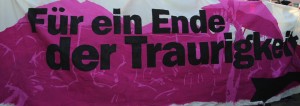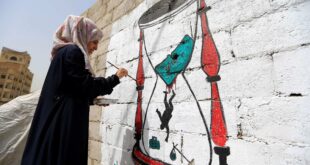 → Italian
→ Italian
In the weeks before the 18th of March, the big event that was supposed to inaugurate the new ECB headquarter was increasingly reshaped. The great party that originally should have been became a modest happy hour and, finally, a coffee-to-go, made possible by a huge deployment of policemen. When we reached the blocks of demonstrators coming from every part of Europe, who in the early hours of the 18th of March picketed the access points of the Eurotower, we faced the image of a tremendous trench: barbed wire, hydrants, the black block of German police already dressed up for the party. From the heavens of finance to the ground of precariousness, the austerity is the daily violence that on the 18th of March clearly showed its need to have an armed wing.
On March 18 there wasn’t a siege. Not only because the blocks of demonstrators scattered quickly, moving through the city and regrouping themselves in order to resist an organized repressive action, but especially because it was a byproduct of a long term process, that starting from 2012 has created the conditions for a real mass convergence of European movements. Without this long organizational work there wouldn’t have been a place for the rage conveyed in the streets, and it would be impossible to explain the huge march in the afternoon, when people gathered in Römer Platz before marching through the city. In terms of participation – 25000 people –, the success is largely due to the organizational effort of the German movement and the structures that in these years supported the path of Blockupy, but it goes beyond the national dimension. Frankfurt was the center of Europe not because it is its financial capital, but because thousands of people coming from every corner of Europe mobilized to put an end to sadness – Für ein Ende der Traurigkeit, to recall the words of one of the opening banners – by the insubordination of a continent that refused to obey to financial domination of capital.
Paradoxically, we can say that the achievement of Blockupy lies in the missed promise that its name would suggest. The opening of the new ECB headquarter wasn’t blocked and actually the new tower was working long before the farce of the official inauguration. Yet, in the streets of Frankfurt it was clear the possibility to organize the daily insubordination against austerity and precarization policies even beyond the symbolic actions and the show of a successful riot, both played in the city as its theater. If the outcome of the Greek elections pointed out the chance of a clear-cut refusal of the austerity and its alleged technical unavoidability, in Frankfurt we showed the necessity of a really European autonomous political initiative. Thus, the official opening of the new ECB headquarter puts an end to Blockupy, but after its end Blockupy must go on.
Apparently, the direction is not given. If the aim to block the opening of ECB held an heterogeneous coalition together – a broad spectrum of movements together with unions and European left parties – now it’s time to establish some political priorities, no more just symbolic or related to a counter-institutional big event, but able to turn a general opposition to financial domination of capital in a program shared on a large scale. The point is also to make communicating and connected the paths and spaces of discussion that in the meantime opened and strengthened, making visible and transparent the process of the transnational social strike that has taken a more clear direction.
Also from this point of view, these two days in Frankfurt showed a possibility: on March 18 the Italian strikers, the workers that went on strike in Amazon’s storehouse of Bad Hersfeld and the German Coordination group supporting the strikes have crossed the parade. At the same time, in Bad Hersfeld storehouse hundreds of workers went on strike, thus practically explaining the sense of the banner held up by the demonstrators ‒ Block austerity: strike against precarity and crisis ‒ and affirming the necessity to re-politicize labour struggles and the struggles against precarity on a European scale. This same necessity has been what inspired more than one hundreds men and women, precarious, workers and migrants, trade-unionists from Sweden and France, Portugal and Italy, Germany and Poland, Great Britain and Belgium, who met on March 19. The meeting discussed starting from a question: Towards a transnational social strike?, knowing that an answer, as the forms of transnational organization, are not given. The individuation of a common day of action could be a first step, but it cannot the solution of this conundrum: only on the medium- and long-term will be possible to produce a real widening and organization, inside and outside workplaces. The workshops held on March 19 made evident the necessity to take charge of the deep differences between the working conditions, the regimes of wage, the legal situations and the forms of trade-unionist and movement initiative across the borders. Nevertheless, from the discussion emerged also the firm political will to find concrete ways to attack the global chains of exploitation and to define a common political platform – for minimum European wage, welfare, basic income and visa for migrants – around which we can create a transnational communication and organization of the struggles against the precarization of labour and life. We shared the necessity to avoid an acceleration of the complex process of connection and involvement of the figures of labour and of precarity. We shared the common commitment to start organizing this process right now, in order to gain force and to share discourses and claims towards the next meeting that will take place in September. The time of transnational social strike has come, transnational social strike needs its time.
Blockupy is already beyond the March 18; it’s already been something more than blockades and demonstrations. However, Blockupy will continue to exist only if it will turn itself into a space capable of allowing the continuation of the processes matured inside it. The same it’s true for the perspective of social strike opened up by the Strike meeting: the social strike will be possible only if we do not presume to export it as a model in Europe, but rather if we are able to take charge of the contradictions, of the differences and of the difficulties that this watchword meets also beyond the Italian borders. In both cases we know that the challenge is not to produce symbolic moments, but real insubordinations in a constant struggle to go beyond the present. This is for us a part of the Blockupy of tomorrow. This is for us a part of the Strike Meeting of Tomorrow. Of course, the point is not to abandon the struggle against austerity politics and against the financial government of Europe, but rather to show the constant and systematic connection between the heavens of finance and the earth of precarity, thus bringing the struggles against the debt, against impoverishment, against unemployment, against exploitation in the heart of Europe, challenging its present material constitution. To get it finally over with sadness.
[slickr-flickr tag=”18nulldrei”]
 ∫connessioniprecarie connettere gli ∫connessi, produrre comunicazione
∫connessioniprecarie connettere gli ∫connessi, produrre comunicazione




